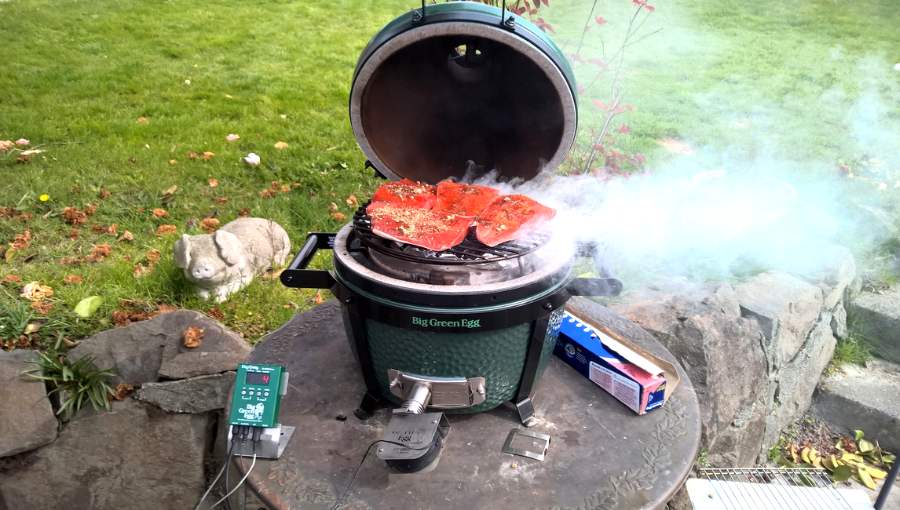Traditionally, using a wooden plank was the go-to method for smoking salmon, but not everyone has access to one. Luckily, there are other ways to achieve delicious and perfectly smoked salmon without the use of a plank.
Every product is independently reviewed and selected by our editors. If you buy something through our links, we may earn an affiliate commission at no extra cost to you.
Today I’ll explore how to smoke salmon on a Big Green Egg without a plank. Whether you’re an experienced or a beginner, this method is easy to follow and will result in a mouthwatering salmon that’s sure to impress your guests.
Can You Smoke Salmon Without A Plank?
Yes, it’s possible to smoke salmon without using a plank. While using a plank can add extra flavor to the salmon and prevent it from sticking to the grill grates, it’s not essential to the smoking process.
Smoking salmon without a plank is a viable option that can still result in delicious and flavorful smoked salmon.
How To Smoke Salmon On A Big Green Egg Without Plank?
Smoking salmon is a wonderful way to elevate this already delicious fish. With its rich and tender flesh, salmon takes on a smoky flavor beautifully. While using a wooden plank to smoke salmon has been a traditional method for a long time, it’s not the only way to achieve delicious results.
What You’ll Need:
- Salt
- Pepper
- Olive oil
- Salmon fillets
- A meat thermometer
- Wood chips (I recommend using fruitwoods such as apple, cherry or peach)
Step 1: Preheat Your Big Green Egg: First things first, preheat your Big Green Egg to 225-250°F. It’s essential to have a consistent temperature throughout the smoking process.
Step 2: Prepare The Salmon: While your Big Green Egg is heating up, prepare your salmon fillets. Rinse them under cold water and pat them dry with paper towels. Remove any bones or skin from the fillets, and season them generously with salt and pepper. Brush each fillet lightly with olive oil to prevent sticking.
Step 3: Soak The Wood Chips: While you’re waiting for the Big Green Egg to reach the desired temperature, soak your wood chips in water for at least 30 minutes. Soaking the chips will ensure that they produce smoke instead of just burning up quickly.
Step 4: Add Wood Chips: Once your Big Green Egg has reached the desired temperature, it’s time to add the soaked wood chips. Add a handful of chips to the hot coals, and wait until you see smoke starting to form before adding the salmon.
Step 5: Smoke The Salmon: Place the salmon fillets on the Big Green Egg’s grates, making sure to leave space between each fillet. Close the lid, and let the salmon smoke for around 30-45 minutes, depending on the thickness of the fillets. Keep an eye on the temperature and smoke production, and adjust the vents as needed to maintain a steady temperature.
Step 6: Check The Temperature: Use a meat thermometer to check the internal temperature of the salmon. When the salmon reaches an internal temperature of 145°F, it’s ready to be removed from the Big Green Egg. If your salmon isn’t quite at the desired temperature yet, keep smoking it until it reaches 145°F.
Remove the salmon from the Big Green Egg and let it rest for a few minutes before serving.
Also Read: How To Make Rotisserie Chicken On Big Green Egg
Smoking Salmon With Planks Vs Without Planks
Smoking salmon with planks and without planks are two different methods that produce different results.
Smoking salmon with planks involves using wood planks, usually cedar or alder, that have been soaked in water for several hours. The salmon is placed on top of the plank, and then the plank is placed on the grill or in the smoker.
The wood plank imparts a smoky flavor to the salmon and also helps to keep it moist during the cooking process.
Smoking salmon without planks involves placing the salmon directly on the grill or in the smoker without using any wood planks.
The smoke is generated from wood chips, chunks, or pellets that are added to the smoker or grill. The salmon absorbs the smoke flavor as it cooks.
Here are some differences between the two methods:
Flavor: Smoking with planks imparts a distinct wood flavor to the salmon, while smoking without planks allows for more control over the type and intensity of the smoke flavor.
Moisture: Smoking with planks helps to keep the salmon moist and tender, while smoking without planks may result in drier salmon.
Complexity: Smoking with planks is a bit more complex, as it requires soaking the planks in water and monitoring the temperature of the grill or smoker to prevent the plank from catching fire.
Smoking without planks is simpler, as it only involves adding wood chips, chunks, or pellets to the smoker or grill.
Ultimately, the choice between smoking salmon with planks and without planks comes down to personal preference. Both methods can produce delicious smoked salmon, but they offer different flavors and textures.
Also Read: Big Green Egg Fire Bowl Vs Kick Ash Basket – Which Suits You Best
Salmon On A Big Green Egg Direct Heat Or Indirect Heat?
When smoking salmon on a Big Green Egg, it’s generally recommended to use indirect heat. Indirect heat means that the salmon is not directly over the flame or heat source, but is instead placed on a rack or plate setter with the heat coming from the sides or bottom of the Big Green Egg.
Indirect heat is preferred when smoking salmon because it allows for a more even and consistent cooking temperature, which helps prevent overcooking or undercooking the salmon.
It also helps to develop a nice crust on the outside of the salmon without burning it.
To smoke salmon on a Big Green Egg using indirect heat, set up the Big Green Egg for indirect cooking by placing a plate setter or heat deflector on the bottom of the Egg, followed by a cooking grate.
Preheat the Egg to your desired temperature, then place the salmon on the cooking grate and close the lid. The salmon will cook slowly and evenly, with the smoke flavor penetrating the flesh.
Also Read: Egg Genius Vs Digiq – Which Suits You Best?
Can You Put Salmon Directly On Big Green Egg?
Yes, salmon can be placed directly on the cooking surface of a Big Green Egg grill. However, it is important to preheat the grill, oil the grates, season the salmon, and monitor the temperature of the grill and salmon as it cooks to ensure that the fish cooks evenly and does not stick to the grates.
The cooking time depends on the thickness of the fish and desired level of doneness. Once cooked, the salmon should be removed from the grill using a spatula or tongs and allowed to rest before serving.
Do I Need To Flip Salmon On A Big Green Egg?
Yes, it is recommended to flip the salmon on a Big Green Egg grill in order to cook it evenly on both sides. Flipping the salmon allows the heat to distribute evenly and helps to ensure that the fish is cooked through without becoming dry or burnt.
When grilling salmon on a Big Green Egg, it is important to use a spatula or tongs to carefully flip the fish over halfway through cooking.
The salmon should be cooked until it is opaque and easily flakes with a fork, which usually takes between 4-10 minutes per side, depending on the thickness of the fish and desired level of doneness.
It is important to monitor the temperature of the grill and the salmon as it cooks, and adjust the heat as needed to prevent overcooking or burning.
Flipping the salmon also allows for any seasonings or flavorings that have been added to the fish to be distributed evenly throughout the fillet.
Do You Close The Lid When Grilling Salmon?
When grilling salmon on a Big Green Egg, the lid should be closed during the entire cooking process, except when flipping the fish or checking the temperature.
Keeping the lid closed helps to maintain a consistent cooking temperature and prevents the salmon from drying out or becoming overcooked.
It is important to monitor the temperature of the grill and the salmon as it cooks, and adjust the heat as needed to prevent overcooking or burning.
Keeping the lid closed also helps to prevent flare-ups and reduces the risk of the salmon sticking to the grates.
What Temp Is Best For Smoking Salmon?
The ideal temperature for smoking salmon is in the range of 175°F to 225°F (79°C to 107°C).
The smoking time for salmon can vary depending on the size and thickness of the fish, but typically takes between 1-4 hours.
It is important to check the internal temperature of the fish using a meat thermometer, and make sure that it reaches a minimum internal temperature of 145°F (63°C) for safe consumption.
Should I Smoke Salmon On Foil?
Smoking salmon on foil is a matter of personal preference and convenience. Foil can help prevent the salmon from sticking to the smoker or grill grates, and it can also make clean-up easier.
However, some people prefer not to use foil as it can interfere with the smoke flavor and may not allow the salmon skin to crisp up as well.
If you decide to smoke salmon on foil, be sure to use heavy-duty foil and create a pouch or packet that seals tightly around the salmon to prevent any smoke or steam from escaping.
This will help to infuse the salmon with smoky flavor and keep it moist during the cooking process.
Ultimately, whether or not to use foil when smoking salmon is a personal choice. It’s worth experimenting with both methods to see which you prefer.
How Long Should Salmon Sit Before Smoking?
It is not necessary to let salmon sit for a certain amount of time before smoking. However, if you are using a dry rub or marinade to season the salmon, you may want to let it sit in the refrigerator for a few hours or overnight to allow the flavors to penetrate the flesh.
If you are not using a dry rub or marinade, you can simply season the salmon with salt and pepper or your preferred seasoning just before smoking.
Regardless of whether you let the salmon sit or not, be sure to pat it dry with a paper towel before smoking to ensure that it cooks evenly and develops a nice crust on the outside.
Should I Use A Water Pan When Smoking Salmon?
Using a water pan when smoking salmon is a matter of personal preference. Some people believe that using a water pan helps to regulate the temperature inside the smoker and keep the salmon moist during the smoking process.
Others prefer not to use a water pan, as it can increase the humidity inside the smoker and may make it harder to achieve a nice crust on the outside of the salmon.
If you do decide to use a water pan when smoking salmon, be sure to keep an eye on the water level and refill it as needed to prevent it from running dry.
You can also add aromatics, such as lemon slices, herbs, or garlic, to the water to infuse the salmon with additional flavor.
Ultimately, whether or not to use a water pan when smoking salmon is up to you. It’s worth experimenting with both methods to see which produces the results you prefer.

